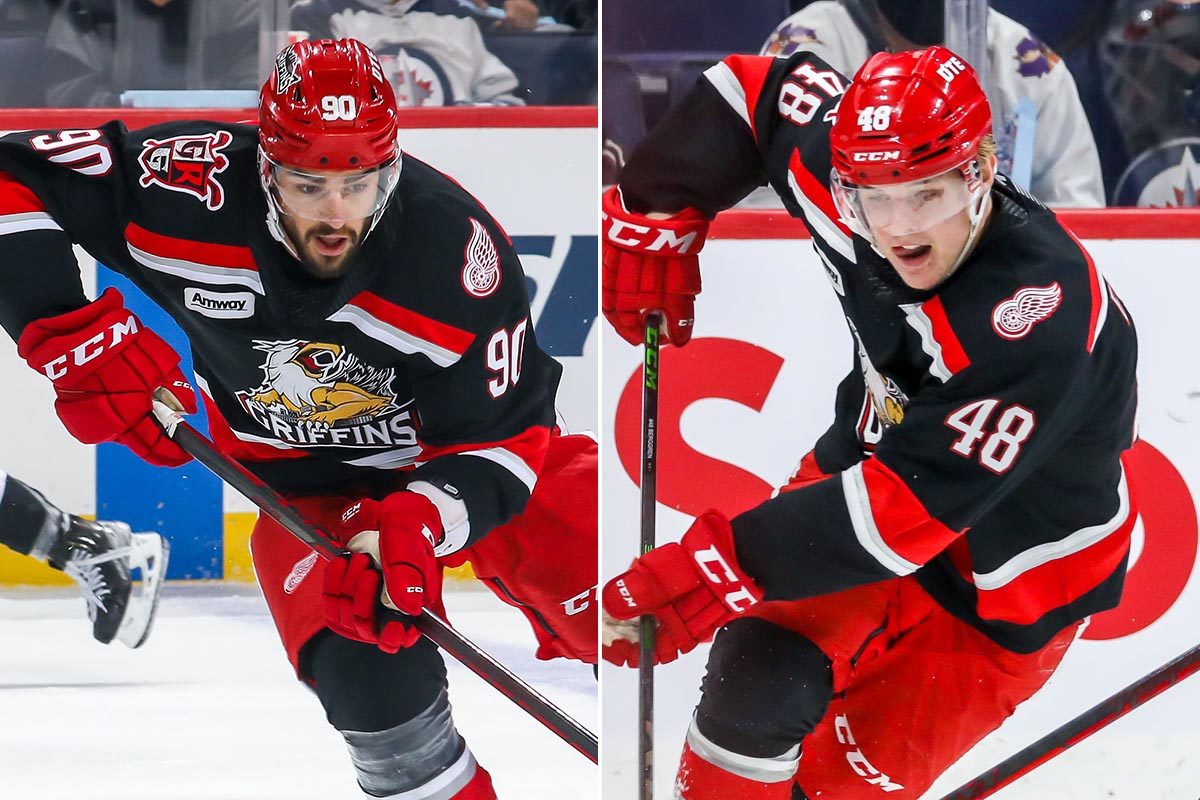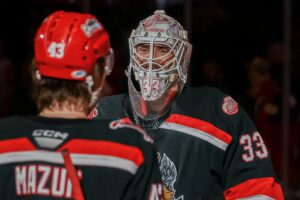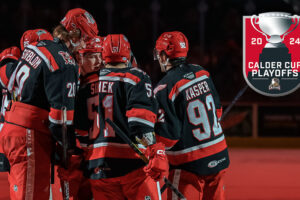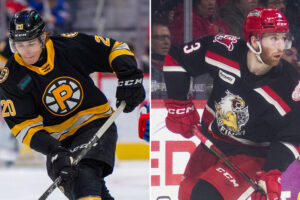📝 by Patrick Williams
Sometimes the American Hockey League serves as a finishing school for top prospects, a step to get them over the hump and whisk them on their way to a long National Hockey League career.
Think Dylan Larkin’s six Calder Cup Playoff games with the Grand Rapids Griffins as a prelude to him eventually ascending to captaining the Detroit Red Wings. Or Nikita Kucherov and Brayden Point, who used stints with the Syracuse Crunch to fine-tune a few loose ends in their respective games before they headed off to NHL stardom and Stanley Cups with the Tampa Bay Lightning.
Other times, though, the AHL means much more long-term project for players, even standout NHL first- and second-round draft picks. Those top prospects will often run into their first significant career obstacles only one step below the world’s top league. Or the AHL is a necessary step to acclimate players trained in Europe’s high-level circuits to what can be a markedly different North American game. If a player needs to adjust to North America, the AHL can certainly accomplish that.
So, multiple pathways to the NHL exist, and the AHL is not a one-size-fits-all development option, least of all with Red Wings executive vice president and general manager Steve Yzerman. With Yzerman running the show in Detroit, patience reigns in the organization, much like it did when he built a Stanley Cup winner with Tampa Bay. Over and over, Yzerman utilized Syracuse to build a deliberate, enduring AHL set-up able to churn out NHL-ready players and fuel Stanley Cup runs.
Since then, Yzerman has taken that Syracuse-to-Tampa Bay blueprint and brought it to Michigan, where a strong Grand Rapids-to-Detroit assembly line has taken root as the Red Wings’ rebuilding project continues.
Two significant pieces in that rebuild are among the last vestiges of the wildly successful Ken Holland era in Detroit, one that featured a 25-season playoff streak and four Stanley Cup championships.
Yzerman returned to Detroit in April 2019 with the Red Wings’ reconstruction project already well underway. He inherited those two key pieces, center Joe Veleno and wing Jonatan Berggren, both jewels from a 2018 draft class that also featured Filip Zadina as the sixth overall pick; Zadina went to Grand Rapids as an 18-year-old, going on to play 80 AHL regular-season contests before graduating to Detroit.
In the 30th slot in that 2018 draft came Veleno, fresh off a 79-point 2017-18 season in the Quebec Major Junior Hockey League with Saint John and Drummondville. Three picks later, Detroit plucked Berggren, who already had 10 regular-season games as a 17-year-old in the Swedish Hockey League with Skelleftea. Then came defenseman Jared McIsaac, who went — three spots, naturally — after Berggren and is starting his second pro season in Grand Rapids as another highly rated prospect.
Offense has been Veleno’s ticket to first-round status, but defensive work is what will take him to Detroit full-time. To that end, he has earned penalty-kill time from Griffins head coach Ben Simon as one of his assignments. Veleno became the first Quebec player to be given exceptional status to play as a 15-year-old in the QMJHL. That enabled him to put in four QMJHL seasons in enough time to enter the AHL as a 19-year-old in the 2019-20 season.
But the AHL can be a rough introduction to the pro game, even for a first-round pick who had posted a 104-point season a year earlier with Drummondville. Veleno picked up 23 points (11 goals, 12 assists) in 54 regular-season games as a rookie with Grand Rapids. Then in 2020-21, with the AHL not yet playing due to the COVID-19 pandemic, the Red Wings loaned Veleno to Malmo in the SHL, where he put up 20 points (11 goals, nine assists) in 46 games before returning to North America to earn his first five NHL games in Detroit as well as four more appearances with Grand Rapids.
After those 10 games in 2017-18, Berggren played 40 regular-season contests across the next two seasons. But he broke out in 2020-21, piling up 45 points (12 goals, 33 assists) in 49 regular-season games, no small feat in a defensively responsible league like the SHL. Now the Red Wings want Berggren in North America, where he can learn the intricacies of a smaller rink amid the AHL’s rambunctious style while he learns to adapt his playmaking skills to this hectic brand of hockey.
All of 21 years old, both Veleno and Berggren are getting down to work in Grand Rapids. Veleno picked up a goal in the Griffins’ season-opening 6-2 home win against Rockford on Oct. 15. A night later in Milwaukee, he added two more goals. Simon used Veleno between long-time AHL sniper Riley Barber and Taro Hirose. Berggren, for his part, earned an assist in the season opener, his first North American pro game. This past weekend against the Manitoba Moose, Simon had Veleno centering Berggren and trusty veteran Turner Elson.
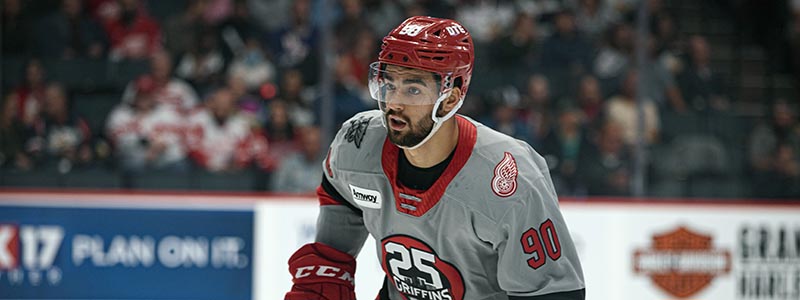
Veleno had made his NHL debut in April, but he found himself back in Grand Rapids as he began his third pro season.
“I mean, it’s definitely disappointing, for sure,” Veleno said of not making the Detroit roster out of training camp. “I thought I had a pretty good camp and pretty good preseason. [But] I knew before going to the camp that I had to be great. The staff and management had said if a younger guy wants to come in and compete for a job, you’ve got to be great. You can’t just be as good as someone else. I think it’s more on me that I think I wasn’t good enough. I wasn’t that much of a standout when I was there.
“I’ve got to show that I could dominate this league and hopefully be back up there in no time.”
So exactly what does Veleno need to do in Grand Rapids?
“I think it’s just to take charge. I mean, I’ve got a big role here, playing in all situations. I think that I’m one of the guys that drives the bus on the offense, and I think that this team is going to rely on me, I guess, to be a leader on the ice and to have a good work ethic, a good attitude, and obviously help the team win.
“I have big expectations for myself right now, and I think we have a good group to support it. I’m going to make the most out of it and play my best while I’m down here to hopefully be called back up soon.”
Simon has been in Grand Rapids since 2015, first serving as an assistant coach for Todd Nelson for three seasons. Current Red Wings Moritz Seider, Tyler Bertuzzi, Michael Rasmussen, Filip Hronek, and Zadina all have taken the Grand Rapids-to-Detroit path. And the blunt-speaking Simon’s take on Veleno?
“For Joe to get back to Detroit, I think he just has to continue to bring it every night,” Simon asserted. “If he can play consistently and prove that he’s dominating this league, he just at that point has to wait for his opportunity, and when that opportunity is afforded to him, to grab a job and take it.
“He’s got to just make sure that he’s controlling what he can control, and that’s his commitment and his play every game.”
Berggren, however, might fall into a somewhat different type of development project for Simon and Grand Rapids. With Seider, and to a lesser extent Hronek and Zadina, Simon is accustomed to handling prospects just — or fairly recently — over from Europe. That means an adjustment period on and off the ice for a young player. Nothing that is impossible, of course, but it can take time.
Said Berggren, “I think this is the best thing for me to go to Grand Rapids and just practice and play some big minutes here with the Griffins.”
Simon, who skated two seasons in Europe as his playing career wound down, understands the process for Berggren.
“He’s coming over,” Simon started. “Now he is getting sent to a different city, a different culture, different language, different rink, different coach. There’s a lot to assimilate yourself to and get acclimated to, and so you never know what to expect.”
But Berggren does have a clear to-do list in Grand Rapids as he starts his adjustment period.
“The AHL is a little bit different, the physicality,” Berggren said. “Sometimes [you need to] just chip instead of finding a play. So I think that [will] be the hardest thing for me to change in my game, to maybe chip more and drive the net more.
“But I will practice that every day.”

TheAHL.com features writer Patrick Williams has been on the American Hockey League beat for nearly two decades for outlets including NHL.com, Sportsnet, TSN, The Hockey News, SiriusXM NHL Network Radio and SLAM! Sports, and was most recently the co-host of The Hockey News On The ‘A’ podcast. He was the recipient of the AHL’s James H. Ellery Memorial Award for his outstanding coverage of the league in 2016.

































